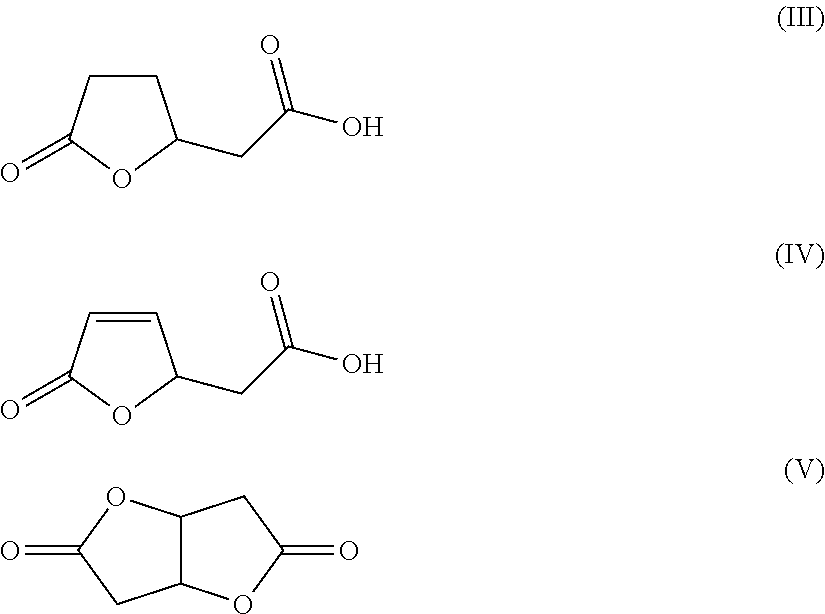Method of producing adipic acid or at least a resultant product thereof
a technology of adipic acid and adipic acid, which is applied in the field of process for preparing adipic acid, can solve the problems of high complexity of conversion of muconic acid on the industrial scale, for example to adipic acid, and use of corrosive acetic acid,
- Summary
- Abstract
- Description
- Claims
- Application Information
AI Technical Summary
Benefits of technology
Problems solved by technology
Method used
Image
Examples
examples
[0206]Feedstocks Used:
[0207]cis,cis-muconic acid (from Aldrich)
[0208]water
[0209]hydrogen
[0210]Raney nickel
[0211]Raney cobalt
[0212]2% rhodium on carbon
Experimental Method for Examples 1 to 3
[0213]
TABLE 1TransitionAdipicMuconicLactones IIIBislactonemetalacidacid (% byand IVVcatalyst C(% by wt.)wt.)(% by wt.)(% by wt.)Example 1Raney Ni95050Example 2Raney Co95050Example 32% Rh / C98020
[0214]A suspension was prepared from 24 g of cis,cis-muconic acid, 56 g of water and 1 g of the transition metal catalyst C specified in table 1, and the suspension was introduced into a 300 stirred autoclave made from 1.4571 stainless steel. Hydrogen was injected to 30 bar, the stirrer was switched on (700 rpm) and the mixture was heated to 80° C. over a period of 20 min. Once the mixture had been heated to 80° C., the hydrogen pressure was increased to 100 bar and this hydrogen pressure was maintained by metering in further hydrogen over the reaction time. After a reaction time of 12 hours, the reaction mi...
example 4
[0215]15 g of 2% Rh / C catalyst were suspended in 150 mL of water and the suspension was introduced into a 250 mL reactor. The suspension was stirred (700 rpm) and heated to 80° C. (internal reactor temperature). This temperature was kept constant over the reaction time by means of a temperature control device mounted in the reactor. 30 g / hour of a 33% by weight suspension of cis,cis-muconic acid in water and 50 standard liters / hour of hydrogen gas were conducted continuously into the reactor. At the same time, liquid and excess gas were conducted continuously out of the reactor, and the liquid volume and the pressure (about 50 bar) in the reactor were kept constant. Upstream of the discharge orifice, the reactor had a sintered metal frit (pore diameter 5 micrometres), which retained the suspended catalyst particles and muconic acid particles in the reactor. Beyond the discharge orifice was the discharge line. The discharge line had a valve which was used to decompress the mixture of...
PUM
| Property | Measurement | Unit |
|---|---|---|
| solubility | aaaaa | aaaaa |
| solubility | aaaaa | aaaaa |
| temperature | aaaaa | aaaaa |
Abstract
Description
Claims
Application Information
 Login to View More
Login to View More - R&D
- Intellectual Property
- Life Sciences
- Materials
- Tech Scout
- Unparalleled Data Quality
- Higher Quality Content
- 60% Fewer Hallucinations
Browse by: Latest US Patents, China's latest patents, Technical Efficacy Thesaurus, Application Domain, Technology Topic, Popular Technical Reports.
© 2025 PatSnap. All rights reserved.Legal|Privacy policy|Modern Slavery Act Transparency Statement|Sitemap|About US| Contact US: help@patsnap.com

